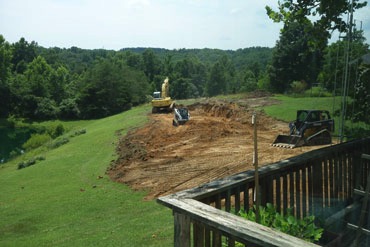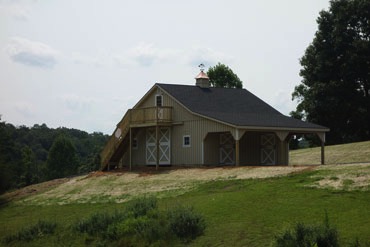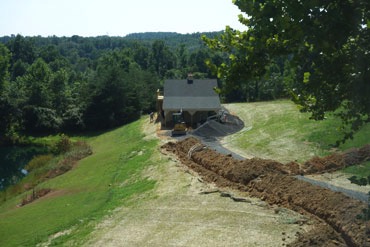Deciding to start a farm
When we decided that we wanted to turn our property into a farm, we had a lot of decisions to make with regard to fencing, paddock divisions, barn placement, barn design, hay storage, etc. Because we live in a horse community, we opted for a design that could be conducive to both camelids (alpacas and llamas) as well as horses. We figured we might someday want to relocate and wanted to ensure that homebuyers with a desire for horses would find our property attractive, given that most of our neighbors have at least 1 horse.
When I bought the property in year 2000, it had three board fencing along the front and about 1/3 the way down the sides, and nothing along the back of the property. The fencing clearly had no purpose beyond its aesthetic properties. We visited several farms and found the 4-board fencing with no climb wiring inside to be the balance between beauty and function, and at 5 ft. tall, it was unlikely many animals would climb over it. Of course with alpacas it is not about keeping them in, it is about keeping predators out. We know we have black bears in the area and we occasionally see other dogs that are out for a stroll on their own. At night we hear coyotes sometimes, but we have yet to see one, though others near us have claimed to see them. Coyotes and dogs are what we are most concerned about keeping out, so the fencing choice was driven by that threat. We found a local company who does amazing fencing, though not inexpensive by any means. However, we decided to pay the extra money knowing that if we went with pine the fence should last circa 20 years and it would serve our purpose as well as any future owner in the event that we move. We rolled out the fence line and found that we had over 5500 ft. of fencing needed, which honestly was a little mind boggling when we did the back of the envelope calculations. We found Google Earth was quite useful for the purposes of design, even though the imagery available was not updated with excavation we had to do for the barn build site.
The barn itself was not an easy decision either. We started by examining other alpaca farms around us and found some attractive features that we wanted to incorporate in to our barn. Namely, we liked having 12x12 stalls with removable walls so that if we wanted to we could make a 12x24 section. We had originally planned on a six stall barn, but when we started looking for a good location on our property, we quickly became frustrated with zoning regulations which requires barns housing livestock to be 100 ft. from the property line. While we were fine on the offset at the front of the house, the side of the house was restricted by the pond in the middle of the property, and a large drop-off on the banks of the pond. We had a great excavator come out and he quickly etched out what he thought he could do for us to get the barn to be next to the pond. It all frankly seemed impossible to us… How could he possibly make such drastic changes to the property without it looking like a war zone? When he began work on the first day, we watched in awe as the ground seemed to be a blank canvas that he could carve into a piece of artwork. Using heavy earth moving equipment, he dug out a road and a beautifully flat area for our barn. He made it all look easy, of course, but it was a serious job, complete with hardscrabble ground and enormous boulders throughout. Though even with large boulders he came out with a hoe ram and removed those rocks after hours of teeth chattering effort.
Barn construction started soon after, two of the 12x24 sections were delivered on a flatbed and driven to location and put in place. Then the following several days three young men came out and constructed the rest of the barn to include the hay loft, stairs to the hay loft, overhangs, and finishing touches to make the barn look just like the pictures in the brochures. The Amish workers had an incredible work ethic; they worked for three days, about 12 hours each day, and the barn was finished. We went to the barn the night it was finished and sat overlooking the pond, and really were in awe by the transformation we had seen in just a few short weeks. We decided to put two automatic waterers in the barn because they would keep the water warm in the winter and the buckets would never go empty. Of course we never suspected the alpacas would turn those waterers into their own special footbath, a maddening side-effect that we weren’t prepared for initially We put in two waterers, one on the north side of the barn and the other on the south side. These of course meant we needed to run water to the barn as well as electric, so that was the next task to get underway. We finally felt we were making some incredible strides towards seeing our dream come true!
Installation of fencing quickly became the long pole in the tent, because the initial estimate of a week quickly turned out to be nearly a month as the installers hit lots of the same hardscrabble ground with rocks/boulders along the fence line that required endless days of jack hammering. Since Amy works from home, this jack hammering made it difficult to concentrate on anything because many of these bedrocks are the same rocks that the house sits on, so despite the jack hammer doing its job 700 ft. from the house, it felt as though someone was jack hammering in the basement.
Since we had done so much excavation around the property, we were able to plant new grass seed in those areas, and replace the native Virginia grasses with an alpaca friendly grass. The grade of the hills throughout the property however meant that we needed to put down a biodegradable mesh to hold down the hay and grass seed in an attempt to prevent all of the grass seed from being at the bottom of the hill. The mesh was stapled to the ground and we were very satisfied with the results – well at least until we decided to bring the alpacas to the property…
When the day finally came to bring our first four alpacas to the farm, we released them in to their new home and they carefully explored the new area and then began running around all playful with their new found freedom. We watched them endlessly and giggled at their antics and were happy to see they enjoyed the newly planted grass. Then a couple of days in while watching them we noticed they were eating some of the mesh that we put down, which of course had us very concerned since it could cause blockages in their stomachs. So for several days we worked tirelessly in the paddocks ripping up the mesh and using field gates to close off portions of the paddocks while we worked. Looking back it is one of those things that defines farming, you look out and think you have finally reached your goal and you have some time to sit back and relax, but alas! No! There is always something pressing to do, always a mistake to correct, a new task to be done. Sleep be damned, it must get done! Welcome to the life of a modern farmer.







